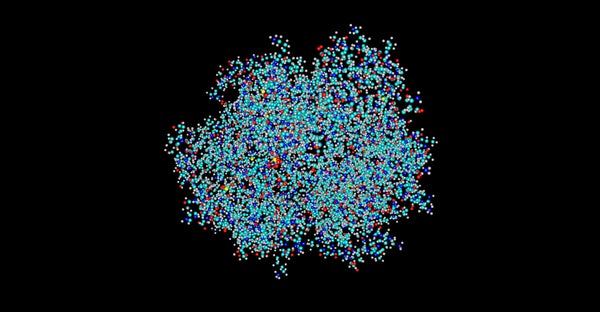When we stare into the periodic table, it’s like looking into a mirror. The essential soft metals we need for life are sodium, potassium, magnesium and calcium, which dissolve easily into the water that makes up much of our body. Among the hard metals we use are iron, zinc and copper. Nearly half of all our proteins contain a metal.
Most of us know iron best for its role in our blood. Four atoms of iron help form the molecule hemoglobin, the protein in a red blood cell that stores and transports oxygen. Every cell requires oxygen to burn the fuel glucose, producing the energy that does the cell’s work. As blood passes through an oxygen-rich environment like the lungs, the iron atoms in hemoglobin bind to oxygen atoms. Later, in oxygen-poor environments—a calf muscle working hard, a brow furrowed—iron atoms release their oxygen.
The relationship of iron to our neurological development is startlingly specific. Children who don’t get enough iron in their first thousand days of life are likely to have a reduced attention span. They will be less able to grasp concepts. They will have greater irritability. They will be more socially withdrawn. They will have delays in language and motor skills.
On supporting science journalism
If you're enjoying this article, consider supporting our award-winning journalism by subscribing. By purchasing a subscription you are helping to ensure the future of impactful stories about the discoveries and ideas shaping our world today.
For the fetus in the womb, iron deficiency increases the chances of a premature birth, low birth weight and birth asphyxia. For the pregnant mother, iron deficiency means a greater risk of infection, pre-eclampsia and bleeding. Worldwide, some 20 percent of maternal deaths are caused by anemia or a shortage of iron.
Doctors use anemia—from the Latin “without blood”—for any condition in which hemoglobin levels are low. When the body doesn’t have enough iron to make enough hemoglobin to shuttle oxygen, you feel tired. You might faint. You are breathless. Apathetic. Depressed. You have a headache. You have palpitations. In severe cases, your heart stops beating.
Some two billion people in the world don’t get enough iron in their diet. Our body can store some iron but not enough for what we need every day. We have to eat iron. We get this metal quickly when we eat meat and fish. Iron is also available in many vegetables, fruits, grains and dairy products. Complexly, though, our absorption of iron is easily inhibited. Take tea with your meal, and the tannin will reduce the iron available to you by a third. If you replace the tea with orange juice, the ascorbic acid will double your absorption of iron. Forget the percentages on food labels. Measuring the availability of iron in your diet is like the dreaded word problem in high school math, spun out by the teacher who never liked you.
People who eat a monotonous diet of unrefined grains like wheat and rice—most of the world’s extreme poor—often suffer from a mineral deficiency. A form of phosphorus in the husks of unrefined grains binds with iron, zinc and manganese as a way to keep these minerals stored in the plant. But mammals don’t have the enzymes to break down these compounds, and so we can’t absorb these stored minerals. (The husks of plants also contain fiber and B vitamins. If you get iron from eating a variety of foods, you should choose unrefined over refined grains as the healthier choice.)
The extreme poor often cannot afford a diverse diet and certainly cannot afford iron supplements or the fortified food in stores. They may be subsistence farmers without access to the new iron-rich crops being developed in agriculture. Sometimes, too, they follow the tradition of feeding small children bland meals of porridge or gruel, while older children and adults are eating stews and vegetables. Diseases like malaria cause or aggravate anemia, as does a lack of vitamins—particularly vitamin A.
In 2000, the United Nations created eight Millennium Development Goals (MDGs). Nearly every country on Earth agreed to the utopian dream of ending poverty and hunger. It was as if a group of earnest 16-year-olds suddenly ran the world. This seemed an entirely good thing.
Goal 5 was to improve maternal health, which included reducing anemia in women of reproductive age. In 2015, when we had failed to achieve the eight MDGs, the U.N. doubled down by creating 17 Sustainable Development Goals. One of the targets, again, was to reduce anemia in women. Again, we are failing. By 2020, not a single country was on target to achieve that goal.
Today, the World Health Organization estimates that 40 percent of pregnant women on Earth are anemic and 42 percent of children under the age of five. One third of all women of reproductive age are anemic. Men, of course, can also suffer from anemia. And iron deficiency is not just confined to poor countries; the CDC estimates that 15 percent of pregnant women and toddlers in America have iron levels below the recommended level.
We know exactly what to do. In 2020, BMC Medicine published a meta-analysis of work being done in 129 countries. The authors concluded that scaling up three interventions would dramatically reduce anemia in women by 2030. Those interventions are treating malaria in pregnant women, giving iron and folic acid supplements to all women of reproductive age, and giving micronutrient supplements to pregnant women. The cost would be roughly US $17 billion over the next nine years.
Every day, we take iron into our bodies and turn this metal into who we are: thought, action, memories, stories. We turn iron into love. That’s remarkable. As with any long-term relationship, however, this one requires work. We simply cannot continue to take iron for granted. We need to fully commit.
This is an opinion and analysis article.
